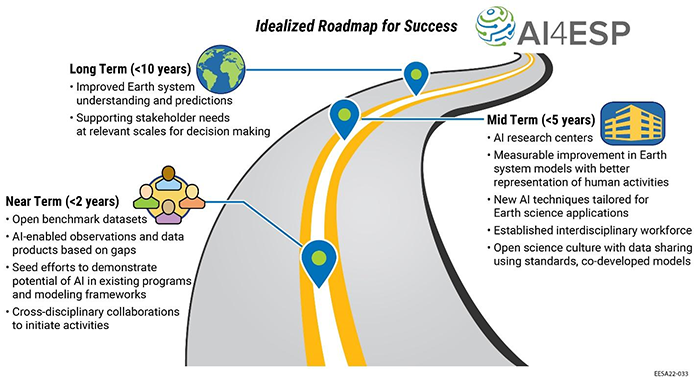AI4ESP Report

The workshop was held from October – December 2021 with participants discussing, debating and exploring how Artificial Intelligence (AI) can advance Earth system predictability across field and laboratory studies, Earth system modeling, and analysis activities.
The report represents the views of the science community when it comes to AI in Earth System Predictability and highlights multiple overarching themes with common challenges, needs, and opportunities across many sessions that were identified by earth science and computational communities. Priorities were characterized based on three major themes (1) Earth science, (2) computational science and methodology, and (3) programmatic and cultural changes to achieve a multidisciplinary and unified framework. As stated in the report: “The success stories that are highlighted in this report and outcomes from the workshop deliberations clearly point to the potential for AI/ML to accelerate integrated, next-generation observations and models that incorporate complex natural and human processes at sufficient resolutions to support emerging science challenges, as well as to improve decision-making”
Figure 1 shows an idealized roadmap to the execution of AI4ESP encompassing near- (2-year), mid- (5-year), and long-term (10-year) activities (Source: Lawrence Berkeley National Laboratory)
Near Term (<2 years)
- Open benchmark datasets
- AI-enabled observations and data products based on gaps
- Seed efforts to demonstrate potential of AI in existing programs and modeling frameworks
- Cross-disciplinary collaborations to initiate activities
Mid Term (<5 years)
- AI research centers
- Measurable improvement in Earth system models with better representation of human activities
- New AI techniques tailed for Earth science applications
- Established interdisciplinary workforce
- Open science culture with data sharing using standards, co-developed models
Long Term (<10 years)
- Improved Earth system understanding and predictions
- Supporting stakeholder needs and relevant scales for decision making
Publication
- Hickmon, Nicki L., Varadharajan, Charuleka, Hoffman, Forrest M., Collis, Scott, and Wainwright, Haruko M. Artificial Intelligence for Earth System Predictability (AI4ESP) Workshop Report. United States: N. p., 2022. Web. doi:10.2172/1888810.
This article is a part of the E3SM “Floating Points” Newsletter, to read the full Newsletter check:



